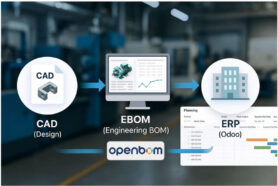
Contract manufacturing is utilized by the majority of companies manufacturing a physical product. Companies from startups to Fortune 500’s work with contract manufacturers (CM’s) to manufacture their products. Unfortunately, most of us don’t understand what a CM is and how to properly leverage their CM. Understanding how to utilize your CM’s resources and services can help you reach your full potential.
An Interesting Story First…
Contract manufacturing didn’t start yesterday. In fact, Contract manufacturing can go back many decades to when manufacturers started to outsource their work in defense and some other complex industries. Check the SupplyChainDive article – How contract manufacturing evolved from the Space Age to the Digital Age which speaks about the interesting story of SCI Systems.
A Huntsville, AL, businessman, Olin King, founded Space Craft in 1961 to build satellites and communications gear for NASA, the U.S. Navy, and other governmental agencies. When NASA funding dried up in the mid-1970s, King took advantage of relationships forged with OEMs while working on the space programs.
“King knew he had all those capabilities — equipment capacity, people, and systems — so he went to companies like IBM and said, ‘let me build for you,’” said Ron Keith, founder of Riverwood Solutions, a Texas-based supply chain consultancy, and managed services company.
IBM agreed. In a 2005 interview, King, who died in 2012 at age 78, explained how it worked.
“They came to us with a box of 150 parts and some drawings and asked us to build it,” King said, according to AL.com. “So we did. Then they brought 500 more and we built that, but they still wouldn’t tell us what it was. Then they asked for 1,000 more, and we said ‘OK, but here’s some things we did to improve it.’ That turned into the IBM PC1.”
What is Contract Manufacturing?
Understanding contract manufacturing is quite simple. Contract manufacturing is a type of outsourcing in which a hiring company (the brand) enters into an agreement with a supplier to make their product.
You can usually take two routes for your manufacturing journey. The first option is to purchase the machines to fabricate the parts for your product and to assemble it in-house. The second option is to find a company that has machines and processes in place to fabricate and assemble your product.
The largest example of this in practice is how Apple hires Foxconn to assemble Apple’s products. Instead of Apple opening up their own production facility, they leverage the position Foxconn is in and hire them to assemble their products. Apple works with many other suppliers but Foxconn is usually the one that takes all the credit.
To take this a step further, your CM is the company that takes on the responsibility to procure and assemble your product, manage the order as well as the supply chain for your product.
The Benefits of CM
Most of us chose a CM because they have a competitive advantage in making products. They have the infrastructure, resources, talent, machines, suppliers, which makes it much easier to get the ball going for production. Of course, some companies end up assembling their own products but those are the outliers with a unique situation.
Resource Management
Most of us do not have an unlimited budget. We need to allocate our resources and budget wisely. This usually means taking responsibility for tasks we can drive efficiently, such as engineering and sales. The areas in which you don’t have an advantage, such as production, are outsourced to a company that can help you.
Skill Sets
If you outsource production, you will most likely lack employees with a specific skill set that streamline your production process. These skill-sets include both skilled and unskilled workers that work together to maximize efficiency, eliminate waste, decrease lead times and figure out ways to reduce your overall costs.
Cost-Effective
Outsourcing production means you do not need to invest in your own factory. You will not be responsible for additional salary, maintenance costs, investments, and additional costs of running a CM. From another costing standpoint, your CM can identify low-hanging fruits and initiate a cost reduction project on your behalf.
Faster Lead Times
The alternative to finding a CM is making products yourself which will be drawn out. Also, Just as CM’s can review your correct costs, they can review your lead times associated with each part, item, or subassembly to see if alterations can be made to improve your overall lead time.
Quality
One of the most important reasons you will choose your CM is because of their mindset on quality and of the quality practices they have in place. Issues always present themselves during the manufacturing process, but a CM will help you ensure these quality issues are kept under control and resolved as quickly as possible.
Who Needs a Contract Manufacturer?
There is no magic answer to this but you most likely should consider one. No matter the complexity of the type of product you are making, there is most likely a CM out there with experience making those types of products. There are a couple of outliers of course but those are rare.
The most basic answer for this question is that you probably do or should at least look into it. No matter the type of product you have, there is a CM out there that is willing to work with you and has manufactured a product that is similar to yours.
Conclusion
OpenBOM improves the process of how you work with your CM, contractors, colleagues, and other team members. We provide you with the capabilities to seamlessly manage your parts, vendors, bill of materials, purchase orders, and change orders. All BOM, engineering, and manufacturing information are stored in the cloud which you can share with anyone.
Register for FREE to create your OpenBOM account and reach out to us via support @ openbom dot com if you have any questions.
Regards,
Jared Haw
Join our newsletter to receive a weekly portion of news, articles, and tips about OpenBOM and our community.









